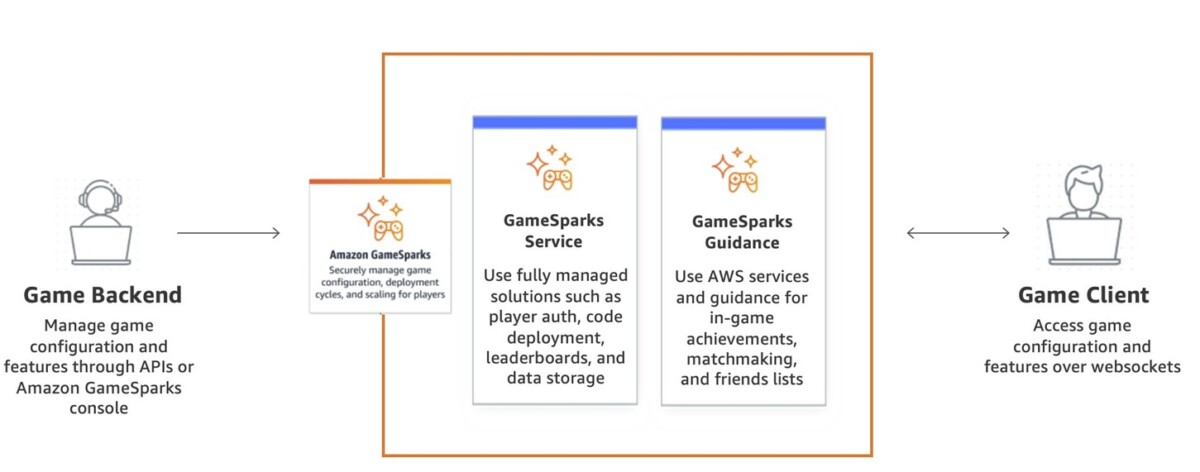
Amazon GameSparks launches guidance for in-game achievements, player matchmaking, and friends lists

At the Game Developers Conference 2022, Amazon Web Services (AWS) announced the preview of Amazon GameSparks, a fully managed service that makes it easier for developers to build and manage their game backend features… Today, we are excited to announce new guidance to help customers build and cu…
At the Game Developers Conference 2022, Amazon Web Services (AWS) announced the preview of Amazon GameSparks, a fully managed service that makes it easier for developers to build and manage their game backend features. The service is relevant for game studio production teams that want to use built-in integrations and game features to reduce the time and cost it takes to launch and maintain a game.
Today, we are excited to announce new guidance to help customers build and customize in-game achievements, player matchmaking, and friends lists capabilities using AWS services with Amazon GameSparks.
Traditionally, a game developer had to build a backend feature from scratch in order to customize it to fit their needs. Spending development time on backend feature code is resource intensive and takes focus away from building unique game features and player experiences. With Amazon GameSparks guidance, developers can quickly configure and deploy new backend features into their AWS accounts alongside the fully managed Amazon Gamesparks features that include player authentication, player identity, code deployment, leaderboards, and data storage.
Guidance solutions provide architectural templates and sample code for implementing the most commonly used game backend features. With just a few clicks from the AWS Solutions Library page, game developers can start deploying a growing list of Amazon GameSparks guidance solutions to improve player experience, monetization, and retention.
Let’s explore each feature in more depth.

Figure 1: build and manage a game backend with GameSparks services and guidance
In-game achievements
Achievements are a set of objectives or challenges developers can add to a game to motivate players and increase engagement and retention. In-game achievements can relate to the inherent goals of the game itself, like beating a certain level or boss, or offer additional challenges through secondary goals such as finding hidden secrets, or defeating 100 enemies without losing a life. As there can be gameplay implications for completing achievements, developers need a server-based model for defining achievements and validating a player’s progress.
Guidance for Achievements with Amazon GameSparks demonstrates how developers can build an Achievement system using Amazon GameSparks and Amazon DynamoDB. Using this guidance, developers can define Achievements and the required metrics to unlock them, as well as instrument their game clients to send metric updates when players complete in-game tasks. Achievement progress is validated server-side and automatically unlocks for players once completed. Developers can use the provided tooling to deploy the sample code and resources into their AWS accounts.
Player matchmaking
An important part of session-based multiplayer games is matchmaking. Matchmaking is the act of matching players together into a game session, typically with certain constraints in place to ensure players of equal skill level and game latency match with each other. After players are grouped together, they can be placed on a game server that’s geographically close to them for an optimal player experience. This becomes increasingly complex as a game scales, so developers need a solution that can streamline their custom player matchmaking and server placement process to fit their game.
Guidance for Matchmaking with Amazon GameSparks helps developers implement real-time multiplayer matchmaking through Amazon GameSparks using Amazon GameLift FlexMatch. It includes all the architecture and code required to configure and initiate FlexMatch matchmaking through GameSparks to group players together, and to place grouped players into games hosted on pre-configured Amazon GameLift servers. Developers using Amazon GameLift FleetIQ can also make use of this Guidance to deploy a standalone matchmaker for their own game server integrations.
Friends lists
Social interactions and connecting with friends increase a player’s emotional connection with a game and is a common feature for developers to keep players engaged. Friends lists are a core functionality of social features in games, enabling players to manage a list of in-game friends and engage with them in gameplay activities. For developers building cross-platform online games, it’s crucial that players playing on different platforms can add each other to their Friends lists and play together.
Guidance for Friends Lists with Amazon GameSparks demonstrates how developers can build a Friends list system for their game using Amazon GameSparks and Amazon DynamoDB. This guidance provides support for setting a display name, sending friend requests, accepting or rejecting requests, and retrieving a list of friends for a player. Developers can use the provided tooling to deploy the sample code and resources into their AWS accounts.
Conclusion
The new Amazon GameSparks guidance announced today makes it easier for developers to customize and extend their backend features to build, run, and grow their games. Using the guidance, developers can quickly customize their backend use cases to meet their needs without having to build the features from scratch. Customers can get started with Amazon GameSparks and deploy solutions in just a few clicks from the AWS Solutions Library.
Additional resources
Author: Ryan Greene
